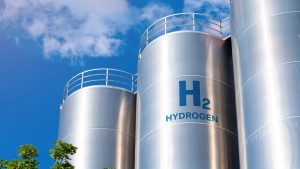Celia Greaves, CEO of the Hydrogen Energy Association (formerly known as the UK HFCA), explains why 2024 is the time to push forward on costs, supply chains, and regulatory uncertainty for the UK and global hydrogen industries.
Hydrogen was firmly at the forefront of the worldwide political agenda in 2023, with a wave of government support schemes introduced to guarantee viability for low-carbon H2 projects across the globe.
We saw the launch of the US clean hydrogen production tax credit, the EU’s green H2 auctions, the German-led H2Global scheme, India’s National Green Hydrogen Mission, and Australia’s Hydrogen Headstart, and support is materialising via production tax credits (PTC) and financial support for hydrogen hubs in the US, renewable hydrogen mandates in the Renewable Energy Directive (RED III) in Europe, and contracts for difference (CfD) in Japan.
In the UK, there was a raft of announcements from our Department for Energy Security and Net Zero, including £400m backing for 11 major projects receiving capital and operational support under our first Hydrogen Allocation Round – an important boost for the economy demonstrating the investment appeal of UK hydrogen.
At the start of this year, we released our UK Hydrogen Projects Map – the first of its kind, mapping out the swell of incredible work going into the hydrogen economy and shining a light on projects which are post-FEED or have been shortlisted for public funding, raising awareness among investors, governments, and key players in the hydrogen industry. The map covers over 70 hydrogen production projects plus others across the value chain – and we expect it to grow quickly.

Now, three months into 2024, the time is ripe for us to take stock and not just highlight progress to date but review the challenges we have ahead of us to keep up the momentum.
Challenges ahead
Inflationary pressures on the cost of production, supply chain issues, and offtake challenges are some of the issues that projects are facing this year.
Costs and cost expectations have risen substantially, particularly for renewable hydrogen. Multiple factors have caused this increase – higher labour and material costs, higher cost for building the balance of electrolyser plants, higher cost of capital, and an increase of renewable power cost by more than 30%.
However, the cost of producing renewable hydrogen is expected to decline to 2.5 – 4.0 USD/kg towards 2030, driven by advancements in electrolyser technology, manufacturing economies of scale, design improvements, and reduction in renewable power cost.
Getting projects over the line is also an issue, and development in this space is a bit of a ‘cause and effect’ situation in that it is necessary to build a market for clean hydrogen if projects are to attract private investors, but the sector needs to reach sufficient scale to be competitive.
Lenders require consistent cash inflows to back hydrogen projects, and while some developers are willing to offer hydrogen under long-term agreements on a cost-plus-premium basis, a gap remains between production costs and off-takers willingness to pay for cleaner alternatives.
Hydrogen projects are also facing rising costs for capital and materials, as with other parts of the renewables sector, further complicating the ramp-up of the nascent industry.
Underpinning standards
One of the key concerns globally is the need to underpin the hydrogen industry with consistent and appropriate permitting and standards frameworks.
The main issue at play here is that ordinarily, these would take a considerable amount of time to come to fruition. And in the hydrogen space – and indeed where climate change is concerned – time isn’t on our side. Unlike other industrial transformations, which have happened over decades and longer, the hydrogen transition needs to happen quickly if we are to meet our net-zero goals.
We are trying to move quickly, and permitting and similar issues – around planning approvals, for example – are preventing us from making the deployments that we need to make fast enough.
Being proactive rather than reactive is key here to prevent these delays and smooth the path for scale-up. This applies not only to production but also to use and transportation/storage.
Individual nations are moving forward with national certification schemes, and we will need to translate these quickly into a widely recognised international scheme if we are to facilitate a trusted and resilient trade in low-carbon hydrogen. Commitments at the recent COP could help forge the way here.
Skills for the future
Another global challenge for hydrogen is the potential for a worldwide skills shortage if we do not invest appropriately and quickly.
Demand for science, technology, engineering, mathematics, digital, and data science skills will be high across the sector, with the majority requiring college and graduate qualifications.
And there is an urgent need not just to bring new skills into the industry, but work to transfer skills from areas such as fossil energy already deeply embedded across the UK.
Alongside traditional engineering, construction, and maintenance skills, we believe that training in areas such as policy and regulations, system integration, energy modelling tools, climate change and sustainability, and future industry growth would help ramp up skills transition in the UK, supported by technical training in hydrogen storage and hydrogen safety to support an emerging hydrogen economy.
Offtake agreements
Despite the challenges faced by the hydrogen industry, the number of announced projects for low-emission hydrogen production is rapidly expanding. According to the latest International Energy Agency (IEA) report, annual production of low-emission hydrogen could reach 38 Mt in 2030 if all announced projects are realised, although 17 Mt come from projects at early stages of development.
However, another significant barrier to the bankability of hydrogen projects is the lack of offtake agreements – and this remains a global problem.
The private sector has started moving to adopt low-emission hydrogen through off-take agreements, but more than half are preliminary agreements with non-binding conditions. Some companies are developing projects for low-emission hydrogen production for their own use, without the need for off-take agreements, but even with the addition of these quantities, low-emission hydrogen use is still far from what is needed to meet climate goals.
This means that despite a substantial appetite for hydrogen applications across various sectors driven by decarbonisation agendas, strategic positioning, or energy security concerns, movement is slower than it needs to be.
The EU has produced promising offtake structures and solutions to overcome offtake challenges to EU green hydrogen projects, and we need something similar in the UK for us to stimulate offtake and increase production alongside demand to have that pull through.
Storage and transportation of hydrogen in the UK
Alongside measures to stimulate offtake, we have also been calling for rigorous strategic planning, forward-thinking policies, and a commitment to innovation to develop a vital network for the transportation and storage of hydrogen in the UK.
Our policy paper, The Role for Transport and Storage in Delivering the Hydrogen Transition, released towards the end of last year, urged the Government to take action to maximise the benefits that hydrogen offers for our energy system and environment, outlining considerations inherent in the development of a transportation network for hydrogen, as well as addressing hydrogen storage.

As a fuel, hydrogen is extremely clean, as its only byproduct is water
Our paper was followed by some encouraging developments, with the UK Government releasing details of how it expects to support UK hydrogen transport and storage infrastructure, as well as a ‘Hydrogen Transport and Storage Networks Pathway’ which describes a strategic planning approach which should help ensure the right network is available to support the evolving hydrogen economy and contribute whole energy system benefits.
This sets in place useful foundations for building greater momentum in this area. Moving forward, our work will focus on the role of non-pipeline transportation options, such as road transport, which will be key to delivering not only short- to medium-term transportation (while pipelines are developed) but also long-term solutions for locations in which pipelines do not reach. We are working with the Government on the right policy levers to support this and looking at mechanisms to accelerate innovation to bring down costs and enhance performance.
Optimism for the future
It’s important in our evaluation of the hydrogen pathway to date in the UK that we remember all the positive strides we are making.
Yes, there are many areas where we need to move faster and further – whether this means more investment, more support, or more progress in codes, permitting and certification.
But this year, there are plans afoot to continue boosting hydrogen deployment across the entire value chain.
Collaboration remains one of our strongest assets here in the UK. Hydrogen growth is not siloed, and we strive to take a joined-up approach to the sector, innovation, and opportunity wherever possible.
This can be witnessed firsthand at our HEA Annual Conference, which will be held in London in May, bringing together industry, academia, and government to facilitate the UK’s role as a world leader in hydrogen and to capitalise on the huge opportunities we have for both reducing carbon emissions and driving economic growth.
We also look forward to the UK’s Second Hydrogen Allocation round which we hope will build on existing momentum and ambition to achieve our goals. There are opportunities to further increase the attractiveness of the scheme and attract even more projects, and we’re working with the Government to deliver that. Further subsidy rounds will follow, designed to help the UK hit its overall low-carbon hydrogen production target of 10GW by the end of the decade.
It will also be interesting to see if the COP28 pledges to accelerate the commercialisation of hydrogen, keep the 1.5°C target within reach, and unlock the benefits of cross-border value chains for hydrogen come to fruition.
The shared declaration of intent across governments for mutual recognition of certification schemes for hydrogen and the global benchmark for greenhouse gas (GHG) emissions and implantation of the public-private action statement on cross-border trade corridors in hydrogen, in partnership with the International Hydrogen Trade Forum (IHTF) and the Hydrogen Council will be instrumental in global progress.
An important part of our work in the UK remains in international collaboration. The HEA works with a huge number of organisations, associations, and government groups overseas and is a member of the Global Hydrogen Industries Association Alliance, Hydrogen Europe, and a number of trade associations in Europe and the US.
Decarbonising energy systems is a global effort, and working across the world for gains is vital to reaching climate goals.
The hydrogen economy in a nutshell
Foundations are being put in place globally to create a thriving hydrogen economy, both domestically and abroad. The UK, like other global leaders, faces a number of challenges in 2024 in building accelerated momentum in hydrogen.
In short, we certainly still have a way to go, but we are moving in the right direction.
Please note, this article will also appear in the seventeenth edition of our quarterly publication.










